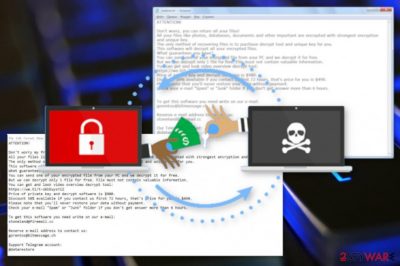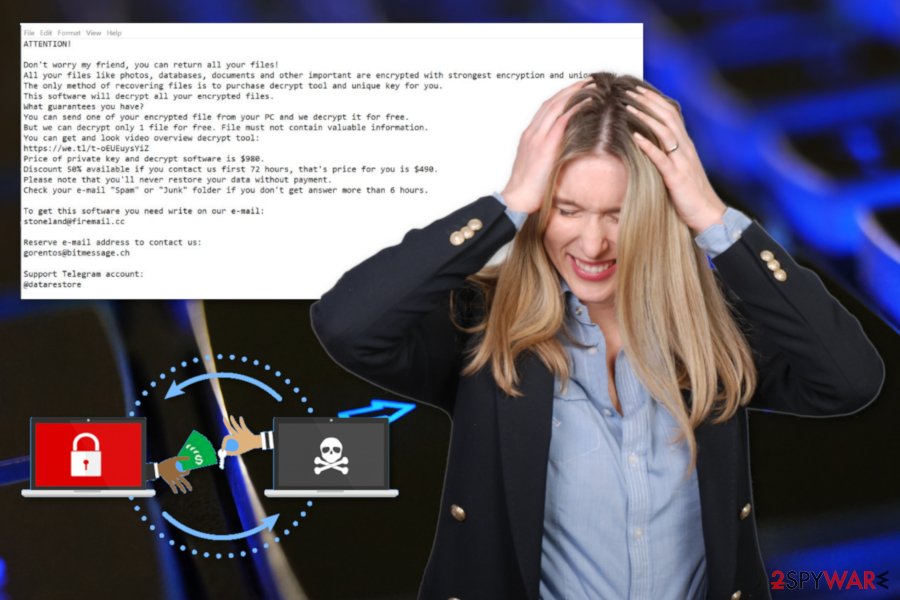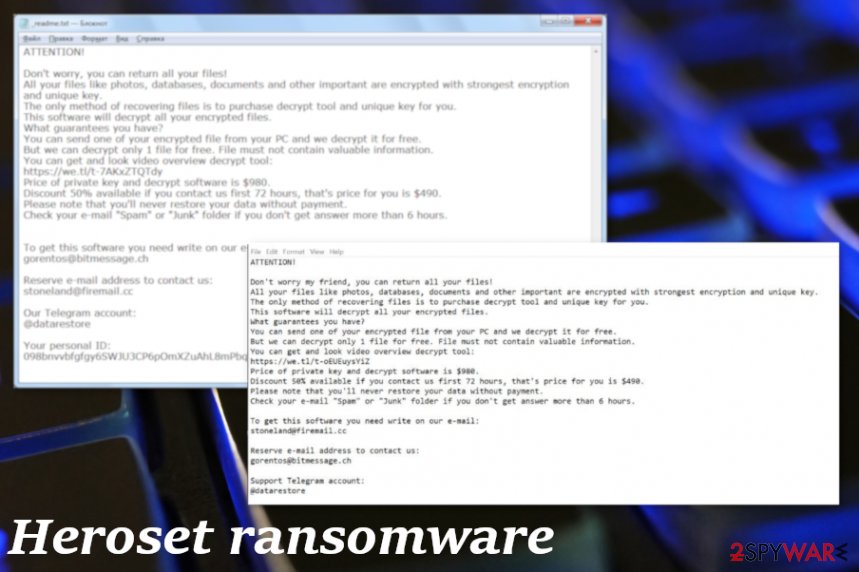Heroset ransomware (Recovery Instructions Included) - Free Guide
Heroset virus Removal Guide
What is Heroset ransomware?
Heroset ransomware is the Djvu virus version that gives less than 72 hours to pay the ransom to its developers

Heroset ransomware is the cryptovirus that encodes victims' files with the specific algorithm (usually, RSA or AES) to demand the ransom. This cyber threat is not a harmless one and its effect on the target computer is noticed right after the infiltration. After adding .heroset file extension to the encrypted data, the virus asks for its victim to contact its developers in less than 72 hours to know how much do they need to pay as a ransom. Since this is a version of Djvu ransomware, we don't recommend relying on these people.
| Name | Heroset ransomware |
|---|---|
| Type | Cryptovirus |
| Family | STOP virus |
| File appendix | .heroset |
| Ransom note | _readme.txt |
| Contact emails | stoneland@firemail.cc, gorentos@bitmessage.ch |
| Decryption? | Possible with STOP decrypter updated by Michael Gillespie |
| Distribution | Spam email campaigns,[1] infected files, software cracks |
| Elimination | Use anti-malware for Heroset ransomware removal and remove virus damage with FortectIntego |
The Heroset ransomware virus is one of many similar versions in the family, so developers can release another version in a matter of days as it was previously done. Fortunately, you can react as soon as possible and remove this malware from the machine. Then, your files can be restored with backups or the updated STOP virus decrypter. However, you need to clean the machine fully before any file restoring to ensure that your data is not damaged in the process.
Heroset ransomware starts the infiltration with a system scan to make sure that the machine is not encrypted already. Also such malware targets particular places, so it checks the location of the device and finds files for encoding process which is the main goal of the attack. When data gets encrypted, virus developers can demand payment.
The main ransom message displayed by Heroset comes to the computer once all selected files get encrypted and marked with .heroset file appendix. _readme.txt reveals more details about the ransomware attack, encryption and offers to contact developers via stoneland@firemail.cc, gorentos@bitmessage.ch in 72 hours or less to get the alleged 50% discount.
However, you shouldn't trust these people since paying 980$ or the reduced amount of 490$ can lead to money loss but not the data recovery. The ransom note that Heroset ransomware delivers is not unique, it matches with other versions in the same virus family and reads the following:
ATTENTION!
Don't worry, you can return all your files!
All your files like photos, databases, documents and other important are encrypted with strongest encryption and unique key.
The only method of recovering files is to purchase decrypt tool and unique key for you.
This software will decrypt all your encrypted files.
What guarantees you have?
You can send one of your encrypted file from your PC and we decrypt it for free.
But we can decrypt only 1 file for free. File must not contain valuable information.
You can get and look video overview decrypt tool:
https://we.tl/t-7AKxZTQTdy
Price of private key and decrypt software is $980.
Discount 50% available if you contact us first 72 hours, that's price for you is $490.
Please note that you'll never restore your data without payment.
Check your e-mail “Spam” or “Junk” folder if you don't get answer more than 6 hours.To get this software you need write on our e-mail:
gorentos@bitmessage.chReserve e-mail address to contact us:
stoneland@firemail.ccOur Telegram account:
@datarestoreYour personal ID:
Heroset ransomware focuses on file locking because when peoples' data becomes useless they get more likely to meet the demand. Such threats affect documents, photos, video and audio files by changing the original code and making the file unreachable. Then the only solution is either decryption or file recovery.

When data becomes useless, the victim tends to believe people behind the threat and pay the amount demanded. Since this is a cyber threat, the ransom needs to be paid in cryptocurrency, this time – Bitcoin. The process of converting the currency may be difficult, so virus creators have brief instructions on the payment itself in the ransom message.
However, we cannot stress this enough that you shouldn't consider paying the ransom when even big companies restrain from that. You better get rid of Heroset ransomware and clean the machine because cryptovirus can cause more than damage to your data.
The researcher who reported about this particular version in the cryptovirus family also develops a decryption tool for files affected in the ransomware attack, so keep an eye for the update and clean the machine, instead of contacting cybercriminals because it can lead to more issues.[2]
Numerous activities initiated by Heroset virus
Additionally to all the file-locking process, Heroset ransomware can:
- copy, delete or steal data stored on the machine;
- gather information about the system or network;
- get access to parts of the device with administrative rights;
- create registry entries or alter existing ones;
- install other files or applications;
- perform other processes in the background.
Because of all these activities, Heroset ransomware removal requires professional tools that could scan the system fully and remove applications, files, and viruses from hidden places. You should also consider FortectIntego and other system tools to make sure that virus damage is fixed and terminated.
Heroset files virus can affect your antivirus tool, security system functions or disable various programs to keep the virus activity persistent. For that reason, we recommend rebooting the PC in Safe Mode before the system cleaning. You can find other tips below the article.
Remove Heroset ransomware as soon as possible as various experts[3] recommends and then check for additional applications by scanning the PC. When your computer is virus-free, you can rely on your data backups and restore files or employ software designed for that.

Cryptocurrency-extortion based threats come via infected files hidden on spam emails
Since cryptovirus is a more sophisticated threat than any unwanted browser application the distribution techniques involve more serious phishing attacks and social engineering instead of deceptive advertising. The main technique used to spread file-locking malware is spam emails.
When malicious actors compose their email spam campaigns they rely on known service or company names that allow hiding their maliciously infected files on the email as a file attachment. Once such data gets downloaded on the machine and opened by the victim malicious macros deliver the payload or direct malware on the PC.
You can avoid such cyber infections by paying closer attention to every received email and deleting any suspicious notifications. Remember that companies are not disclosing financial information to random people and when you are not familiar with the company – the mail may be infected. Clean the email box more often.
The proper Heroset ransomware removal requires a full system scan to delete all associated data and applications
We already noted how many changes Heroset ransomware virus can make on the machine by disabling certain functions or adding and deleting files or programs. You cannot notice the damage since these alterations happen in the registry, system folders.
For this reason, we can recommend Heroset ransomware removal process with automatic anti-malware tools that can find all issues on the machine, malicious files, the main malware and programs added for questionable purposes. A thorough system check indicates all those issues after a few minute scan.
Then you can remove Heroset ransomware and get back to the cleaner and improved device. Rely on SpyHunter 5Combo Cleaner, FortectIntego, or Malwarebytes and check the computer for all the malware traces.
Getting rid of Heroset virus. Follow these steps
Manual removal using Safe Mode
Reboot your device in Safe Mode with Networking and then remove Heroset ransomware with, or anti-malware tool
Important! →
Manual removal guide might be too complicated for regular computer users. It requires advanced IT knowledge to be performed correctly (if vital system files are removed or damaged, it might result in full Windows compromise), and it also might take hours to complete. Therefore, we highly advise using the automatic method provided above instead.
Step 1. Access Safe Mode with Networking
Manual malware removal should be best performed in the Safe Mode environment.
Windows 7 / Vista / XP
- Click Start > Shutdown > Restart > OK.
- When your computer becomes active, start pressing F8 button (if that does not work, try F2, F12, Del, etc. – it all depends on your motherboard model) multiple times until you see the Advanced Boot Options window.
- Select Safe Mode with Networking from the list.

Windows 10 / Windows 8
- Right-click on Start button and select Settings.

- Scroll down to pick Update & Security.

- On the left side of the window, pick Recovery.
- Now scroll down to find Advanced Startup section.
- Click Restart now.

- Select Troubleshoot.

- Go to Advanced options.

- Select Startup Settings.

- Press Restart.
- Now press 5 or click 5) Enable Safe Mode with Networking.

Step 2. Shut down suspicious processes
Windows Task Manager is a useful tool that shows all the processes running in the background. If malware is running a process, you need to shut it down:
- Press Ctrl + Shift + Esc on your keyboard to open Windows Task Manager.
- Click on More details.

- Scroll down to Background processes section, and look for anything suspicious.
- Right-click and select Open file location.

- Go back to the process, right-click and pick End Task.

- Delete the contents of the malicious folder.
Step 3. Check program Startup
- Press Ctrl + Shift + Esc on your keyboard to open Windows Task Manager.
- Go to Startup tab.
- Right-click on the suspicious program and pick Disable.

Step 4. Delete virus files
Malware-related files can be found in various places within your computer. Here are instructions that could help you find them:
- Type in Disk Cleanup in Windows search and press Enter.

- Select the drive you want to clean (C: is your main drive by default and is likely to be the one that has malicious files in).
- Scroll through the Files to delete list and select the following:
Temporary Internet Files
Downloads
Recycle Bin
Temporary files - Pick Clean up system files.

- You can also look for other malicious files hidden in the following folders (type these entries in Windows Search and press Enter):
%AppData%
%LocalAppData%
%ProgramData%
%WinDir%
After you are finished, reboot the PC in normal mode.
Remove Heroset using System Restore
Use System Restore to recover the machine in a previous version
-
Step 1: Reboot your computer to Safe Mode with Command Prompt
Windows 7 / Vista / XP- Click Start → Shutdown → Restart → OK.
- When your computer becomes active, start pressing F8 multiple times until you see the Advanced Boot Options window.
-
Select Command Prompt from the list

Windows 10 / Windows 8- Press the Power button at the Windows login screen. Now press and hold Shift, which is on your keyboard, and click Restart..
- Now select Troubleshoot → Advanced options → Startup Settings and finally press Restart.
-
Once your computer becomes active, select Enable Safe Mode with Command Prompt in Startup Settings window.

-
Step 2: Restore your system files and settings
-
Once the Command Prompt window shows up, enter cd restore and click Enter.

-
Now type rstrui.exe and press Enter again..

-
When a new window shows up, click Next and select your restore point that is prior the infiltration of Heroset. After doing that, click Next.


-
Now click Yes to start system restore.

-
Once the Command Prompt window shows up, enter cd restore and click Enter.
Bonus: Recover your data
Guide which is presented above is supposed to help you remove Heroset from your computer. To recover your encrypted files, we recommend using a detailed guide prepared by 2-spyware.com security experts.If your files are encrypted by Heroset, you can use several methods to restore them:
When Heroset ransomware gets deleted, rely on Data Recovery Pro and restore affected files
Use Data Recovery Pro for encrypted or accidentally eliminated files
- Download Data Recovery Pro;
- Follow the steps of Data Recovery Setup and install the program on your computer;
- Launch it and scan your computer for files encrypted by Heroset ransomware;
- Restore them.
Windows Previous Versions is the feature helpful for encoded data
If System restore was enabled, Windows Previous Versions can help recover the useless files
- Find an encrypted file you need to restore and right-click on it;
- Select “Properties” and go to “Previous versions” tab;
- Here, check each of available copies of the file in “Folder versions”. You should select the version you want to recover and click “Restore”.
ShadowExlorer – a method for file recovery
When Shadow Volume Copies are not affected by the virus, you can restore files with ShadowExplorer
- Download Shadow Explorer (http://shadowexplorer.com/);
- Follow a Shadow Explorer Setup Wizard and install this application on your computer;
- Launch the program and go through the drop down menu on the top left corner to select the disk of your encrypted data. Check what folders are there;
- Right-click on the folder you want to restore and select “Export”. You can also select where you want it to be stored.
STOP decrypter can fork for Heroset ransomware affected files
Decryption is possible with STOP decrypter updated by Michael Gillespie
Finally, you should always think about the protection of crypto-ransomwares. In order to protect your computer from Heroset and other ransomwares, use a reputable anti-spyware, such as FortectIntego, SpyHunter 5Combo Cleaner or Malwarebytes
How to prevent from getting ransomware
Protect your privacy – employ a VPN
There are several ways how to make your online time more private – you can access an incognito tab. However, there is no secret that even in this mode, you are tracked for advertising purposes. There is a way to add an extra layer of protection and create a completely anonymous web browsing practice with the help of Private Internet Access VPN. This software reroutes traffic through different servers, thus leaving your IP address and geolocation in disguise. Besides, it is based on a strict no-log policy, meaning that no data will be recorded, leaked, and available for both first and third parties. The combination of a secure web browser and Private Internet Access VPN will let you browse the Internet without a feeling of being spied or targeted by criminals.
No backups? No problem. Use a data recovery tool
If you wonder how data loss can occur, you should not look any further for answers – human errors, malware attacks, hardware failures, power cuts, natural disasters, or even simple negligence. In some cases, lost files are extremely important, and many straight out panic when such an unfortunate course of events happen. Due to this, you should always ensure that you prepare proper data backups on a regular basis.
If you were caught by surprise and did not have any backups to restore your files from, not everything is lost. Data Recovery Pro is one of the leading file recovery solutions you can find on the market – it is likely to restore even lost emails or data located on an external device.
- ^ Catalin Cimpanu. Microsoft warns about email spam campaign abusing Office vulnerability. ZDNet. Technology news.
- ^ What happens when victims pay ransomware attackers?. Trendmicro. Simply security blog.
- ^ Lesvirus. Lesvirus. Spyware related news.





















